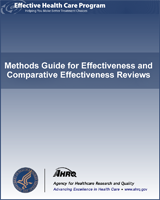NCBI Bookshelf. A service of the National Library of Medicine, National Institutes of Health.
Methods Guide for Effectiveness and Comparative Effectiveness Reviews [Internet]. Rockville (MD): Agency for Healthcare Research and Quality (US); 2008-.

Methods Guide for Effectiveness and Comparative Effectiveness Reviews [Internet].
Show detailsTable 1Studies evaluating reasons for discrepancies in included studies among systematic reviews
| Study | Study Aims | Evaluation |
|---|---|---|
| Hopayian K and Mugford M (1999) Conflicting conclusions from two systematic reviews of epidural steroid injections for sciatica: which evidence should general practitioners heed?6 | The aim of this study was to find the reasons for the discordance between two reviews focusing on use of epidural steroid injection for treatment of low back pain and sciatica and to draw conclusions for users of these reviews. | Each review excluded two papers that the other included, both of which supported the ultimate conclusions of the review that included them. One of these studies was published in a non-English language journal and was excluded by one review. The other papers, however, were published in well-known journals. One of these papers was excluded from one review due to problems with extracting the data, while the other review was qualitative and did not require these data to come to a conclusion. The outcome measures included, and inclusion of non-English language papers account for at least some of the differences. |
| Peinemann F, McGauran N, et al (2008). Disagreement in primary study selection between systematic reviews on negative pressure wound therapy.7 | The objective of this study was to compare systematic reviews on negative pressure wound therapy with regard to their agreement in inclusion of primary studies. | The authors conclude that the reviews differed in inclusion of studies, primarily the inclusion of studies other than nonrandomized controlled trials. They indicate that the differences arise from differences in methodology, classification of study design, and style of reporting excluded studies. Our analysis of this example showed that included study designs varied among reviews. However, only one of the five reviews concluded that evidence supported the use of the treatment, while the others consistently found that the evidence was insufficient, largely due to concerns over quality. The review that found treatment to be effective had the broadest inclusion criteria with respect to study design and ultimately included 25 papers, compared with 14, 6, 6, and 7 included in the other reviews. |
| Cook DH, Reeve BK, et al. (1996) Stress Ulcer Prophylaxis in Critically ill patients: resolving discordant meta-analyses.5 | This study aimed to resolve discrepancies in four previous systematic reviews and provide estimates of the effect of stress ulcer prophylaxis on gastrointestinal bleeding, pneumonia, and mortality in critically ill patients. | From abstract: “The source of discrepancies between prior meta-analyses included incomplete identification of relevant studies, differential inclusion of non-English language and nonrandomized trials, different definitions of bleeding, provision of additional information through direct correspondence with authors, and different statistical methods.” Our analysis of these reviews focused on the prevention of stress ulcer bleeding, as this outcome was common across the reviews. The definition of bleeding differed among reviews. Two more recent reviews came to very different conclusions that can be directly related to the inclusion criteria. One review included both randomized and “quasi-randomized controlled trials,” while the other review included randomized controlled trials with at least 10 subjects per arm published in a variety of languages. In this example, the difference in conclusions in appears to be related largely to inclusion of non-English language articles in one but not the other. |
- Folic acid supplementation and malaria susceptibility and severity among people taking antifolate antimalarial drugs in endemic areas.[Cochrane Database Syst Rev. 2022]Folic acid supplementation and malaria susceptibility and severity among people taking antifolate antimalarial drugs in endemic areas.Crider K, Williams J, Qi YP, Gutman J, Yeung L, Mai C, Finkelstain J, Mehta S, Pons-Duran C, Menéndez C, et al. Cochrane Database Syst Rev. 2022 Feb 1; 2(2022). Epub 2022 Feb 1.
- Review Inclusion of Nonrandomized Studies of Interventions in Systematic Reviews of Intervention Effectiveness: An Update[ 2022]Review Inclusion of Nonrandomized Studies of Interventions in Systematic Reviews of Intervention Effectiveness: An UpdateSaldanha IJ, Skelly AC, Ley KV, Wang Z, Berliner E, Bass EB, Devine B, Hammarlund N, Adam GP, Duan-Porter D, et al. 2022 Sep
- Review Evidence Brief: The Effectiveness Of Mandatory Computer-Based Trainings On Government Ethics, Workplace Harassment, Or Privacy And Information Security-Related Topics[ 2014]Review Evidence Brief: The Effectiveness Of Mandatory Computer-Based Trainings On Government Ethics, Workplace Harassment, Or Privacy And Information Security-Related TopicsPeterson K, McCleery E. 2014 May
- Review Assessing the Risk of Bias of Individual Studies in Systematic Reviews of Health Care Interventions.[Methods Guide for Effectivenes...]Review Assessing the Risk of Bias of Individual Studies in Systematic Reviews of Health Care Interventions.Viswanathan M, Ansari MT, Berkman ND, Chang S, Hartling L, McPheeters M, Santaguida PL, Shamliyan T, Singh K, Tsertsvadze A, et al. Methods Guide for Effectiveness and Comparative Effectiveness Reviews. 2008
- Association between pacifier use and breast-feeding, sudden infant death syndrome, infection and dental malocclusion.[JBI Libr Syst Rev. 2005]Association between pacifier use and breast-feeding, sudden infant death syndrome, infection and dental malocclusion.Callaghan A, Kendall G, Lock C, Mahony A, Payne J, Verrier L. JBI Libr Syst Rev. 2005; 3(6):1-33.
- Table 1, Studies evaluating reasons for discrepancies in included studies among ...Table 1, Studies evaluating reasons for discrepancies in included studies among systematic reviews - Methods Guide for Effectiveness and Comparative Effectiveness Reviews
Your browsing activity is empty.
Activity recording is turned off.
See more...